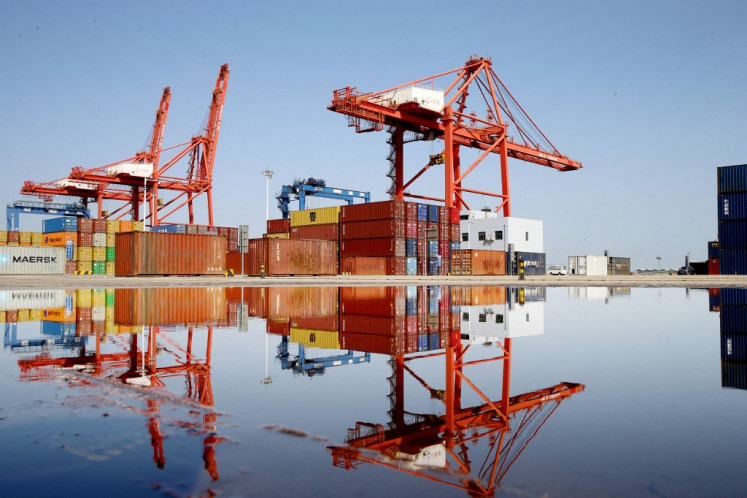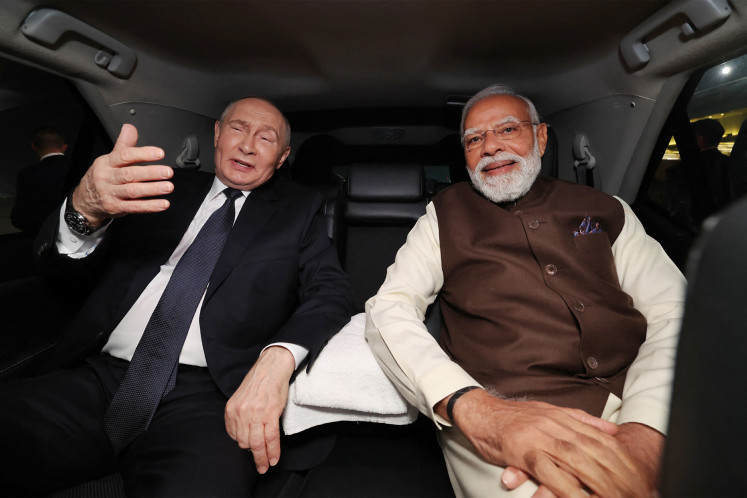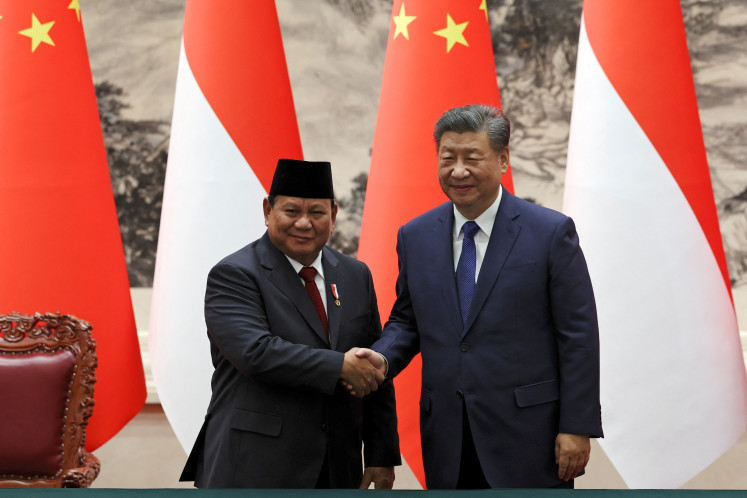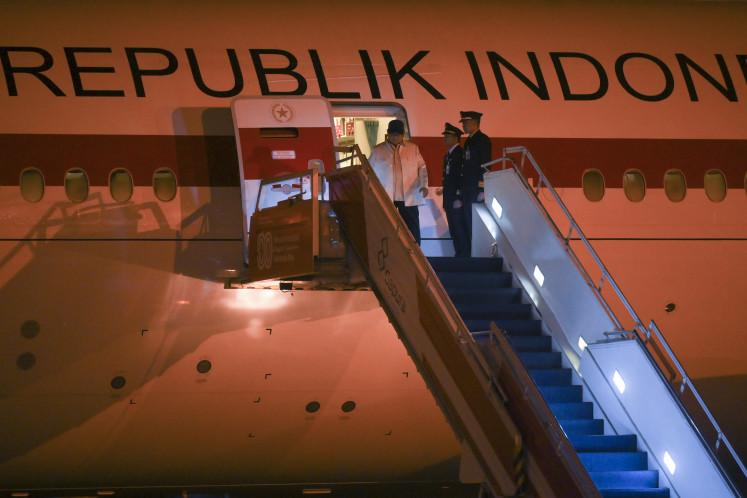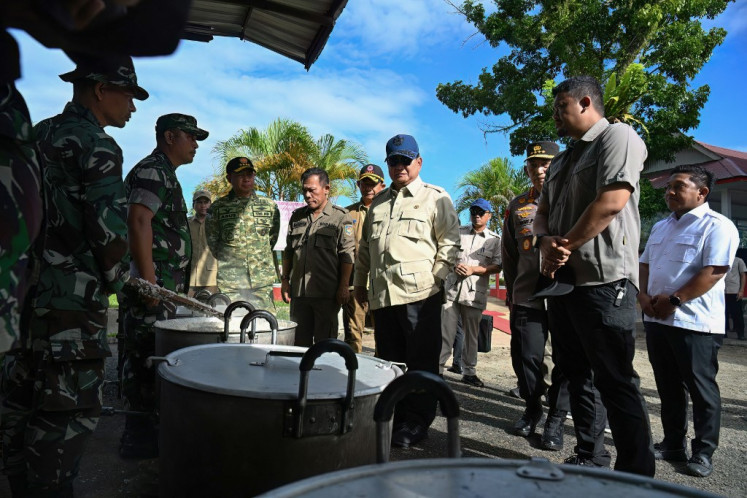Popular Reads
Top Results
Can't find what you're looking for?
View all search resultsPopular Reads
Top Results
Can't find what you're looking for?
View all search resultsBuilding on the Australia-India comprehensive strategic partnership
The US’ punitive tariffs on India present an opportunity for the two countries to strengthen bilateral ties.
Change text size
Gift Premium Articles
to Anyone
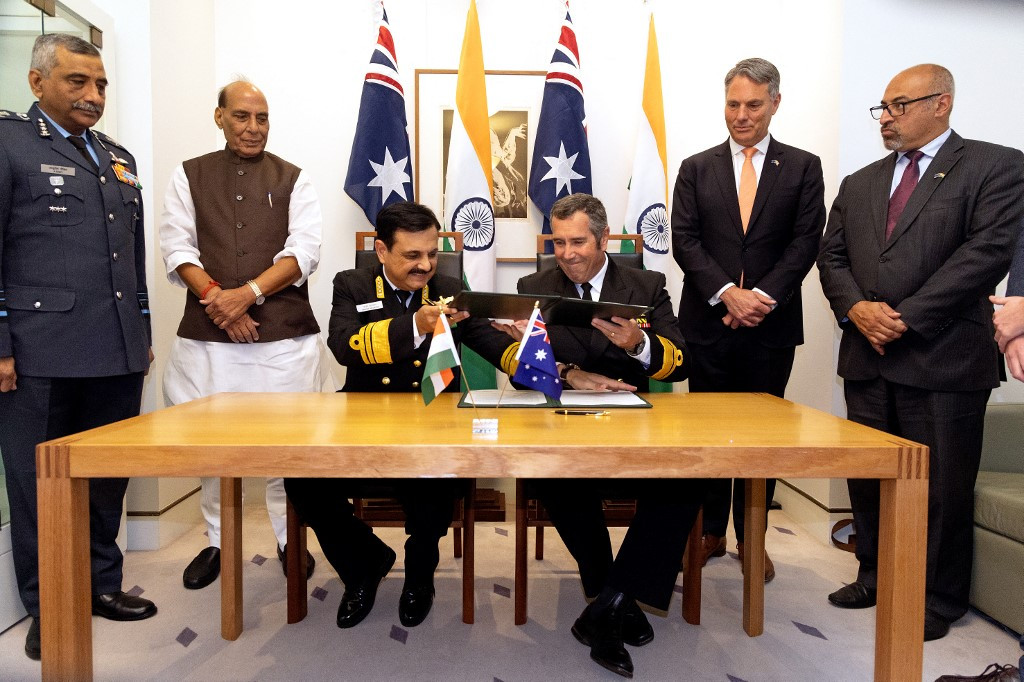 Indian Defense Minister Rajnath Singh (second left) and his Australian counterpart Richard Marles (second right) watch Australian Rear Admiral Matt Buckley (third right) and Indian Vice Chief of Naval Staff Vice Admiral Sanjay Vatsayan (third left) sign a defense agreement on Oct. 9 at Parliament House in Canberra. (AFP/-)
Indian Defense Minister Rajnath Singh (second left) and his Australian counterpart Richard Marles (second right) watch Australian Rear Admiral Matt Buckley (third right) and Indian Vice Chief of Naval Staff Vice Admiral Sanjay Vatsayan (third left) sign a defense agreement on Oct. 9 at Parliament House in Canberra. (AFP/-)
A
mid the gloom, if not doom, over India-United States ties, an Australian defense industry trade mission reached India on Oct. 6. While the objective is to bring together Australian and Indian defense companies in the specialized fields of command, control, communications, cyber-defense, intelligence, surveillance and reconnaissance, the expected partnership is already being described as “truly seismic” by the Australian High Commissioner to India.
Australia’s goal is to see India as an “indispensable security partner”, and the recent visit by India’s Defense Minister Rajnath Singh to Canberra, the first in 10 years, appeared to have solidified five years of the establishment of India-Australia Comprehensive Strategic Partnership. Singh also chaired a business roundtable in Sydney.
More importantly, three agreements were signed to deepen cooperation in information sharing, maritime security and joint activities.
Bilateral ties between India and Australia have grown deeper over the years. The multifaceted engagement ranging from defense and security, trade and investments, to green and clean energy, have only intensified. This has given an enduring character to their engagement.
The Indian diaspora too has facilitated promoting cultural diplomacy that has eased communication between the two countries. It was their involvement in Australian politics, and India’s liberal democratic structure that led to a comprehensive strategic partnership in 2020.
Now, upholding a “Free and Open Indo-Pacific”, coupled with Donald Trump’s unpredictability, and the uncertain future of Quad (Australia, Japan, India and the US), makes it imperative to strengthen ties between Australia and India. This may not contain China but fulfill a shared responsibility to maintain international law and order, and commitment to deepen democracy and freedom for all.
The Labour government’s win in the May elections and the return to power of Anthony Albanese, the first prime minister to win two consecutive elections in the last 20 years, is significant in many ways.
This indicates that Australian foreign policy is making significant adjustments for being both a US ally, and developing self-reliance by increasing its force posture and defense capability.
The Albanese government has maintained and enhanced friendly relations with its immediate neighbors such as Indonesia and ASEAN members, Papua New Guinea and Pacific Island countries.
Immediately after winning the elections, Albanese made his first visit to Indonesia, emphasizing good neighborly relations for a secure Australia.
Australia’s proactive role in the Indo-Pacific was reflected in its defense deal with Papua New Guinea, which aligned the Indian and Australian militaries’ goal to get unbridled access to select sites around the Pacific island nation.
Meanwhile, India’s Act East and extended neighborhood policies are interlinked to the wider Indo-Pacific agenda. The Indian shift in regional power dynamics is aimed at seeking strategic partnerships with countries that share similar concerns about China.
Both Australia and India strongly support institutionalizing the Indo-Pacific for better regional governance mechanisms, with a large number of countries supporting free, open, inclusive, prosperous and peaceful norms. They are working closely on the Indo-Pacific Ocean Initiative (IPOI) to comprehensively manage the entire maritime domain.
India’s SAGAR initiative, or Security and Growth for All in the Region, not only underscores the importance of the Indian Ocean states but also its projection as a “net security provider” in the region.
Multi-alignment is the order of the day. Australia and India are pursuing increasingly aligned foreign and defense policies of armed neutrality, maintaining rules-based order, democracy and self-reliance. This is finely blended to suit their national interests and foreign policies.
The Australian defense industry’s visit to Delhi earlier this month is expected to enhance Indian Ocean stability and peace. It can also be extended toward the Pacific Island countries Papua New Guinea and Solomon Islands where India is equally invested under the Forum for India and Pacific Island Countries (FIPIC). These 14 Pacific Island countries can work toward securing the Indian and the Pacific Ocean from illegal, unreported and unregulated fishing and armed robbery in the Indo-Pacific region and in creating resilient lifestyles and infrastructure to combat climate change.
Australia also has a large reserve of critical minerals necessary for India for its transition to green energy and ensuring energy security.
In this backdrop, it remains to be seen how Trump’s tariffs on India will impact its role in the Indo-Pacific and how adroitly it balances and strengthens its ties with Australia and Southeast Asian states.
There is also the looming question of a rapprochement between India and China that could undermine Indo-US defense and security relationship.
More importantly, the future of Quad itself comes into question.
India might be able to absorb the tariff shock as the US’ punitive measures could blow over in the medium term. But doubts remain over China’s willingness to deal with the border dispute or its geopolitical ambitions. China’s assertiveness and its political, diplomatic and defense posturing do not reflect accommodation when it comes to India’s interests.
The Quad has become a major institutional or rules based force in the regionalization process. After 2017, its members strictly followed institutional proceedings and framing norms for a ‘free and open Indo-Pacific.’
In the event Trump does not back off on tariffs, the Quad member states will not just have to pool in financially for mutual stability and prosperity but will need the backing of Vietnam, South Korea and New Zealand, besides the ASEAN countries and Indonesia, to be more involved in Indo-Pacific regionalism.
The major task ahead for Australia-India relations will be to strengthen three key institutional platforms, the Indian Ocean Rim Association, Indian Ocean Naval Symposium and FIPIC, which can be achieved by deeper Australian initiatives to involve the Pacific Island Forum as a dialogue partner. Consistent and comprehensive interactions between India and Australia will be crucial for the Indo-Pacific region.
---
The writer is an associate professor at the Centre for Indo-Pacific Studies, Jawaharlal Nehru University, New Delhi. The article is republished under a Creative Commons license.





